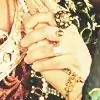How the Mughal Army Fought Wars - Contd.The cavalry was the elite wing of the army. About 1 lakh horses were imported into India from the Balk, Bukhara and Kabul every year. And the emperor made a neat profit on their import. 😆
In late 16th century, a horse could cost about Rs 1000 while a slave girl cost only Rs 40-60.
Cavalrymen were usually heavily armed. "at their sides good swords; under them sheves of arrowes; on their shoulders bucklers, and upon their backs guns fastened with belts; at the left side bowes hanging in cases, and lances about 2 yards and a halfe long (having excellent steele heads), which they carry in their hands."
A Mughal cavalry charge must have been an awesome sight and it would have been something to watch a cavalier gallop into action mounted on a imported horse.
The horses of Amirs had embroidered saddles adorned with precious stones, and tassels of yak tails on the front and back of their saddles as well as the heads of their horses. When the cavalier would be riding at full speed or when a good wind would be blowing, these tassels would fly in the wind and it would look like the horse had wings - a delightful sight indeed to behold!
The infantry had the lowest status and lowest pay. It was huge in size but had porters, postal runners, gladiators, wrestlers, palanquin-bearers, water carriers etc on its rolls. It was ill-equipped, ill-disciplined and more a liability than an asset in war.
Gunners were part of infantry. They ahd no rank and were known as tufangis. This was a pity because Indian, esp Mughal guns, were better than European guns in quality. Firearms came to India from the middle east. They were used in Kashmir, Gujarat and Kerala for the first tie in late 15th century. Babur was the first to use cannons and muskets effectively on a battlefield for the first time in India.
Common weapons were the sword, the bow and arrow and the spear. The Rajputs usually used a short spear with shield, dagger and sword.
Shields were made of leather and had inch-long nails protruidng from them.
Soldiers wore a coat of mail. But the emperor preferred the jubba, a coat made of thick quilted silk or cotton that could bend the point of a sword!
Size
Akbar led the largest army unit in his Deccan campaign - about 80,000 horsemen. But after him, the size kept increasing. Aurangzeb led a cavalry of 170,000 in his Deccan campaign.
Pay
The Ahadis, the personal guards of the emperor, were paid around Rs 500 per month! Ordinary royal mounted soldiers got Rs 7 to 8, apart from money for maintenance of their horses and equipment. This could go up to Rs 13-15 if the soldier had an imported horse. This salary was same as that of a physician!
Artillerymen were paid Rs 7 to Rs 13.
Mansabdars paid their men as they pleased.
Passwords
Yes, there were passwords back then too! 😊 One for the tribe and one for the whole army. Since the armies had no uniforms or dress code, passwords were used to identify friend from foe on the battlefield.
Technology
Military technology was changing. Infantry with its guns, cannons and muskets was replacing the cavalry in importance. New military discipline, new formations and tactics were needed but the Mughals were slow to adapt.
Conventional Mughal campaigns under Akbar would consist of cavalry charges as soon as the enemy came into sight. (Though Humayun and Sher Shah Suri would face each other at close quarters for weeks without engaging in battle. 😲)
Capturing Forts
This was a slow, tedious process during Mughal times. Cannons were not good enough to breach the walls of the fort. Mining was foiled by counter mining.
Storming a fort was extremely risky as the defenders in the fort would attack them with bricks, stones, arrows and bullets and even pour boiling pitch on them. Defenders would even fire cannons, throw lighted bombs, blazing sheets steeped in naptha, bundles of burning grass. Very primitive and barbaric but effective in those times!
How I wish we could see some of this war strategy and tactics in the show, but alas!































